How to launch Shopify store
The potential of e-commerce is vast and continually expanding, offering businesses of all sizes the opportunity to reach global markets with relative ease. As more consumers turn to online shopping for convenience, selection, and value, e-commerce has become a critical element of business strategy. Here’s a look at the potential of e-commerce and the advantages of using Shopify, one of the leading e-commerce platforms.
Potential of E-Commerce
- Global Reach: E-commerce breaks down geographical barriers, allowing businesses to reach customers worldwide. This global marketplace can significantly increase a company’s customer base.
- Lower Costs: E-commerce businesses often have lower operating costs than brick-and-mortar stores since they can eliminate expenses related to physical premises and adjust inventory more efficiently.
- Data Collection and Personalization: Online selling platforms provide businesses with valuable customer data, enabling personalized marketing and improving customer experiences through targeted promotions and recommendations.
- Scalability: E-commerce platforms make it easier for businesses to scale up or down based on demand, inventory, and other factors, without the need for a physical expansion.
- 24/7 Sales: Unlike traditional retail stores, e-commerce websites can operate and accept orders 24 hours a day, providing convenience for customers and continuous sales opportunities for businesses.
What is Shopify?
Shopify is a comprehensive e-commerce platform that allows individuals and businesses to create and manage their own online stores. It provides a wide range of tools and features to help users sell products directly to customers around the world.
Advantages of Using Shopify
- Ease of Use: Shopify is known for its user-friendly interface, making it easy for businesses to set up and manage their online stores without the need for technical expertise.
- Customizable Themes: Shopify offers a wide range of customizable themes, allowing businesses to design their stores to match their brand identity.
- Integrated Payment Solutions: Shopify provides integrated payment processing, supporting various payment methods and currencies, which simplifies the transaction process for both businesses and customers.
- Reliability and Security: As a hosted platform, Shopify ensures that online stores are always available to customers and protects against data breaches with robust security measures.
- Scalable Infrastructure: Shopify can accommodate businesses of all sizes, from small startups to large enterprises, and scales to handle increases in traffic and sales, ensuring smooth operation during peak periods.
- App Ecosystem and Integration: Shopify’s extensive app store allows businesses to add features and integrate with other software, enhancing functionality and improving efficiency.
- SEO and Marketing Tools: Shopify includes built-in SEO features and marketing tools to help businesses attract more visitors to their sites and convert them into customers.
Benefits of sourcing products from India
Sourcing products from India presents several benefits for businesses looking to diversify their supply chains and access unique products. Here’s a brief overview of the key advantages:
- Cost-Effectiveness: India is well-known for its cost-competitive manufacturing environment. Lower labor and production costs can significantly reduce expenses, allowing businesses to enjoy higher margins or competitive pricing.
- Quality: Despite the lower costs, many Indian manufacturers adhere to high-quality standards across various industries, including textiles, jewelry, leather goods, and electronics. The emphasis on quality control has improved over the years, making India a reliable source for quality products.
- Unique Products: India offers a rich variety of unique products, especially in categories such as textiles, handicrafts, spices, and jewelry. The country’s diverse cultural heritage is reflected in its products, many of which are made using traditional techniques that add distinctiveness and appeal in the global market.
- Skilled Labor: India has a large, skilled workforce that excels in various sectors, from intricate handcrafting to advanced technology and IT services. This skilled labor force is capable of producing a wide range of goods and services that meet global standards.
- English Proficiency: The widespread use of English in India facilitates communication and business transactions, making it easier for international buyers to negotiate and maintain relationships with Indian suppliers.
- Growing Infrastructure: India has been continuously investing in improving its infrastructure, including ports, roads, and telecommunications, which enhances the efficiency of manufacturing and supply chains.
- Government Support: The Indian government has implemented various policies and initiatives to boost exports and make it easier for foreign businesses to source products from India. This includes simplified tax regimes and incentives for export-oriented industries.
By leveraging India’s cost advantages, quality production capabilities, and unique product offerings, businesses can effectively enhance their product lines and competitiveness in the global market.
Why Shopify?
Shopify presents a host of advantages for new entrepreneurs venturing into the e-commerce space. Its comprehensive features are designed to simplify the process of launching and managing an online store, making it an ideal platform for those just starting out. Here are some key benefits:
- User-Friendly Interface: Shopify’s intuitive and user-friendly interface makes it easy for entrepreneurs with little to no technical expertise to set up and manage their online store. The dashboard is straightforward, allowing users to add products, create pages, and manage orders with ease.
- Scalability: Shopify is built to accommodate the growth of your business. Whether you’re starting with a few products or plan to expand your inventory significantly, Shopify can handle the increase in traffic and transactions. This scalability ensures that new entrepreneurs won’t need to migrate to a different platform as their business grows.
- Integrated Payment Solutions: Shopify simplifies the payment process by offering integrated payment solutions, including its own Shopify Payments as well as support for other major payment gateways. This means entrepreneurs can accept payments from around the world without the hassle of setting up third-party payment processors.
- Comprehensive Security: Security is a critical concern for online businesses, and Shopify provides robust security features, including SSL certification for data encryption and PCI compliance to secure credit card information. This level of security builds trust with customers and protects the business from potential data breaches.
- Mobile Optimization: With mobile commerce on the rise, Shopify ensures that all its themes are mobile-responsive. This means your online store will look great and function well on any device, providing a seamless shopping experience for customers on the go.
- SEO and Marketing Tools: Shopify includes built-in SEO features and marketing tools to help drive traffic to your store. From optimizing product pages for search engines to creating blog content and integrating with social media platforms, Shopify provides a range of tools to increase visibility and attract customers.
- Rich App Ecosystem: Shopify’s extensive app store allows entrepreneurs to extend the functionality of their online store with apps for marketing, SEO, inventory management, shipping, customer service, and much more. This flexibility lets you tailor your store to meet your specific business needs.
- 24/7 Support: Knowing you have continuous support is crucial, especially for new entrepreneurs. Shopify offers 24/7 customer support via email, phone, and live chat, ensuring that help is available whenever you need it.
For new entrepreneurs, Shopify offers a comprehensive, easy-to-use platform that can grow with your business, providing all the tools needed to launch, manage, and expand your online store effectively. Start your e-commerce journey today with Shopify and take the first step towards building your online business empire
Getting Started with Shopify
Setting up a Shopify account and launching your online store is a straightforward process that can be completed in a few steps. Here’s a step-by-step guide to get you started:
Step 1: Sign Up for Shopify
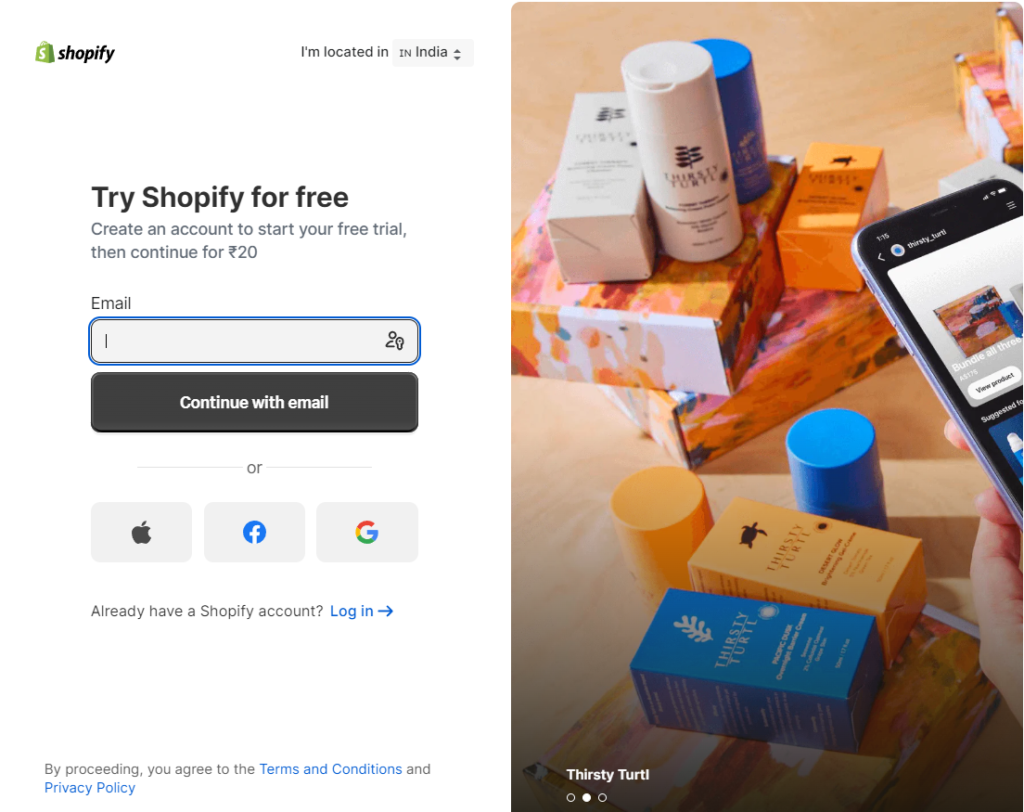
- Go to Shopify’s website and click on the “Start free trial” button. Shopify typically offers a 14-day free trial, which is a great way to explore the platform’s features.
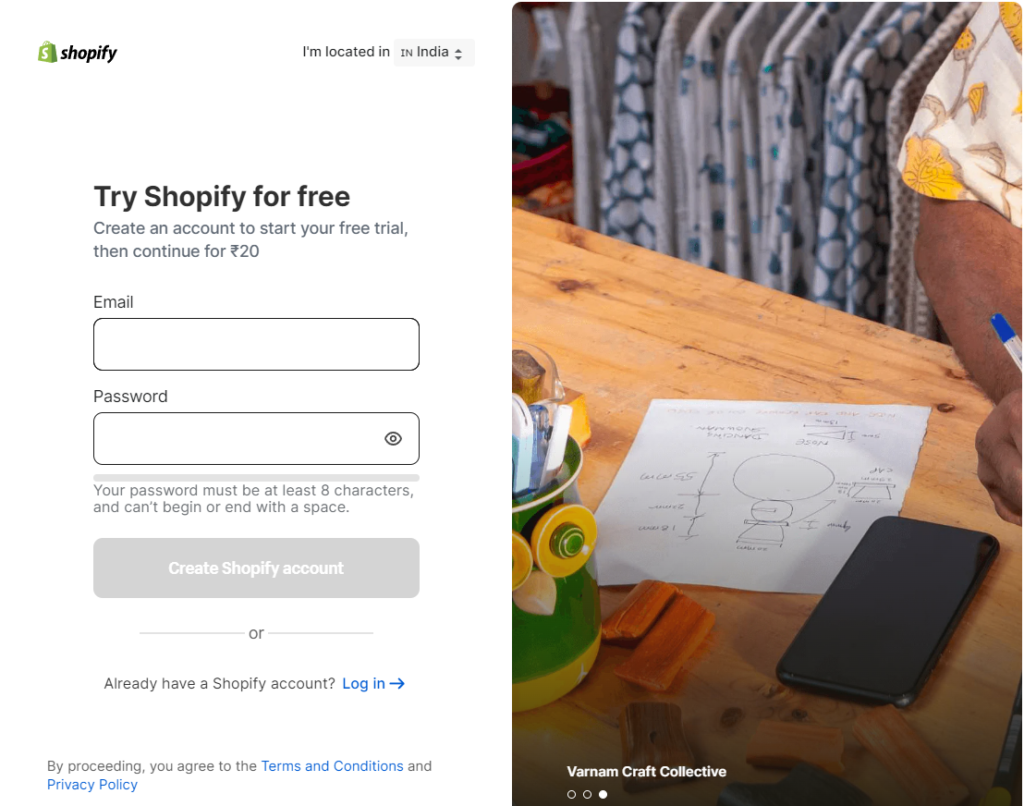
- Enter your email address, password, and store name. Your store name will be used to create your default Shopify domain (e.g., mystore.shopify.com). Choose a unique name that reflects your brand.
- Fill out the subsequent forms with information about yourself and your business. This includes details like your name, address, and what you plan to sell.
Step 2: Choose a Theme
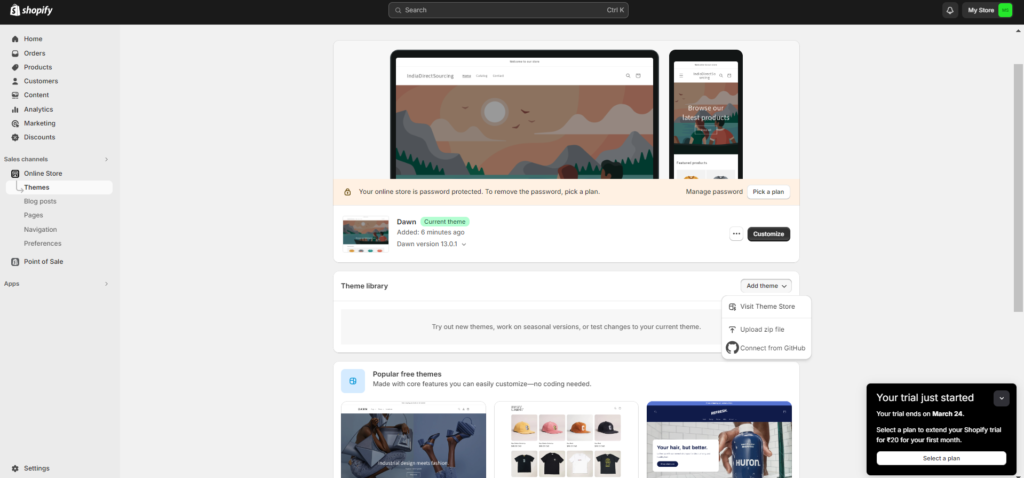

- Navigate to the Shopify Theme Store. From your Shopify admin dashboard, go to “Online Store” and then “Themes”.
- Explore the themes. Shopify offers a wide range of free and paid themes. Use filters to narrow down choices based on your industry or desired features.
- Preview themes to see how they look and function. When you find one you like, click “Add to theme library” to select it for your store.
Step 3: Customize Your Store
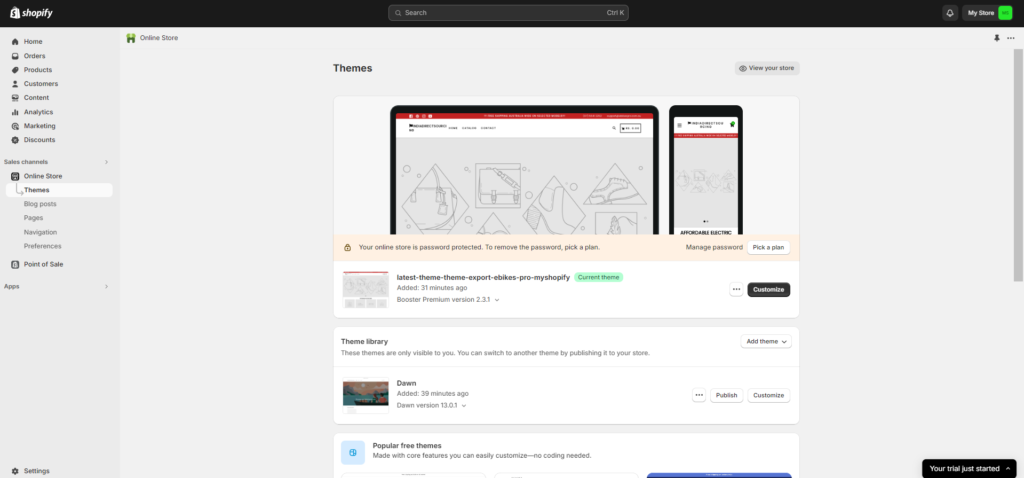
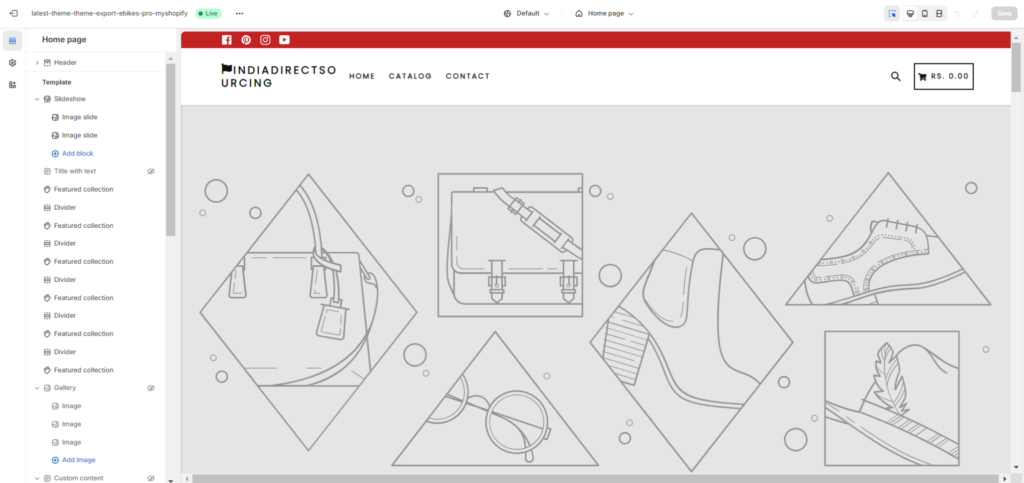
- Access the theme editor by clicking “Customize” next to your theme under “Online Store > Themes”.
- Edit the layout and design. You can add, remove, or modify sections (like banners, featured products, etc.) and adjust colors, fonts, and images to match your brand.
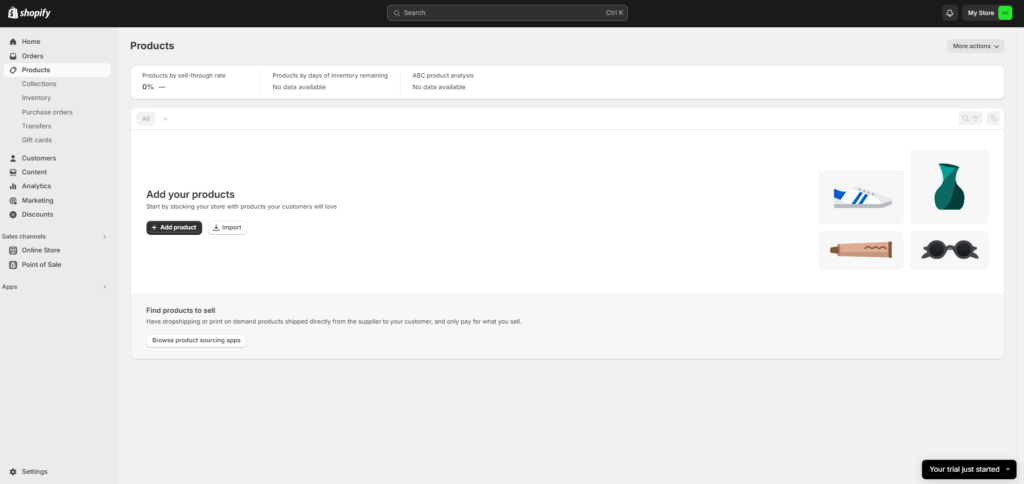
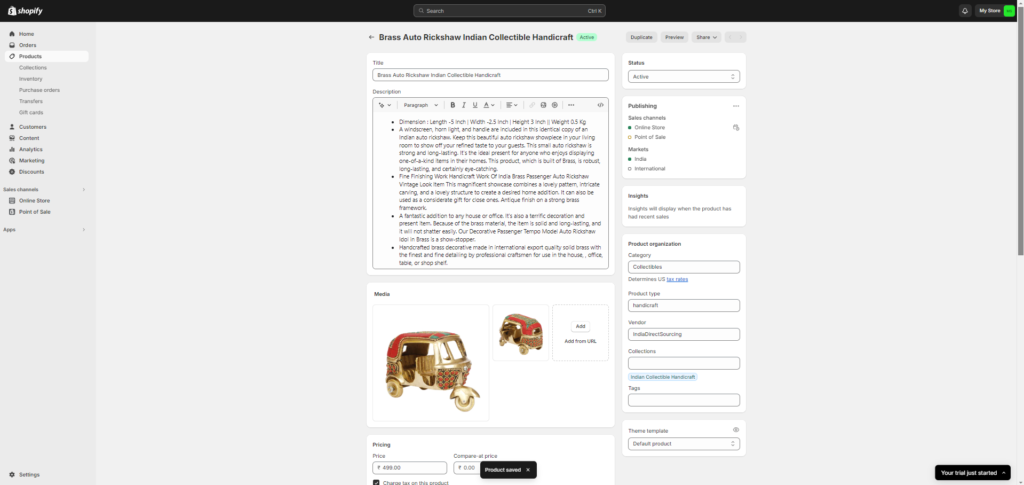
- Upload your products. Go to “Products” from your admin dashboard and click “Add product”. Fill in details like product name, description, images, and pricing.
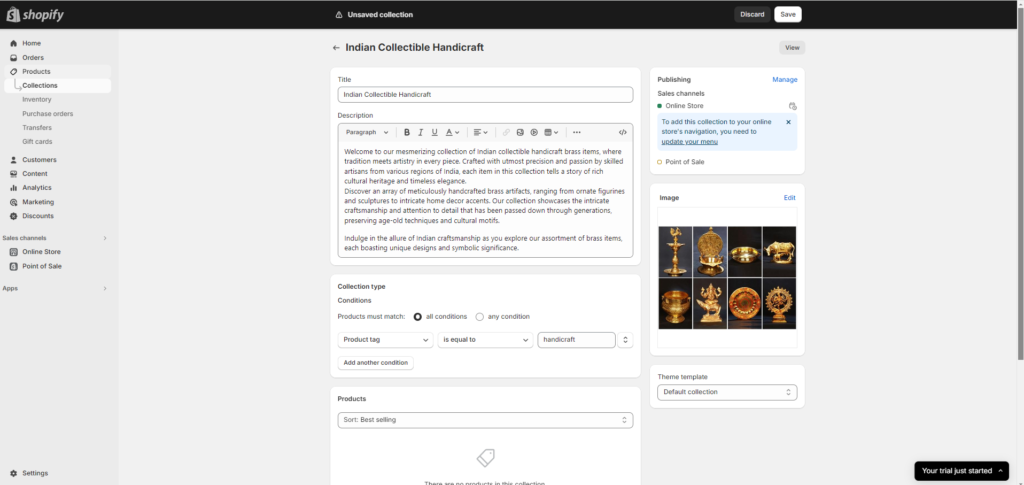
- Organize your products into collections (optional) for easier navigation. This could be based on categories, sale items, etc.
Step 4: Set Up Payment Options
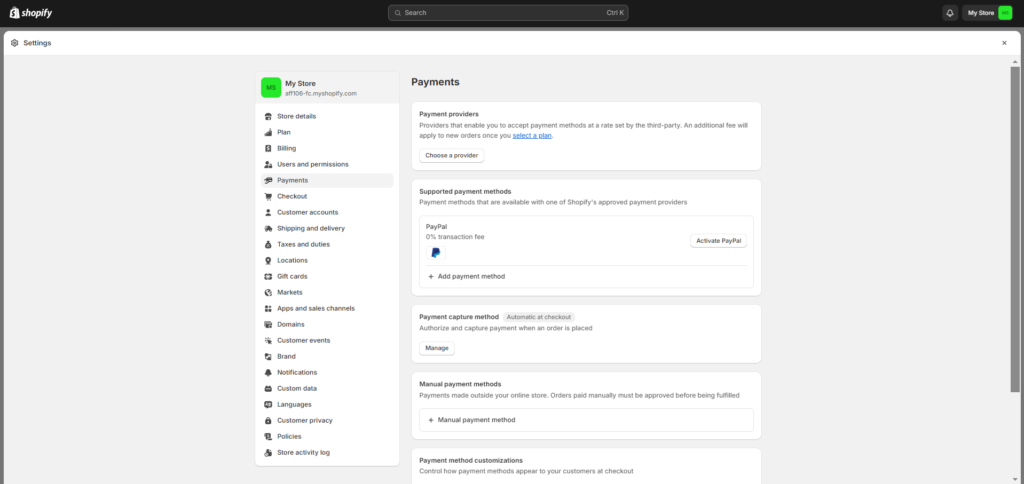
- Go to “Settings” and then “Payments” from your Shopify admin.
- Choose a payment provider. Shopify Payments is the simplest option to accept payments, but you can also use third-party providers like PayPal, Stripe, etc.
- Complete the required setup for your chosen payment gateway. This might involve filling out business and bank details.
Step 5: Configure Shipping Options

- Navigate to “Settings” and select “Shipping and delivery”.
- Set up your shipping zones. These are the areas where you’ll ship your products. You can define rates based on order price or weight.
- Choose your shipping rates. You can offer free shipping, flat-rate shipping, or calculated rates provided by carriers.
- Configure additional shipping settings as needed, such as processing times and package dimensions.
Step 6: Launch Your Store
- Remove the password protection. By default, your Shopify store is password-protected. To go live, go to “Online Store” > “Preferences” and disable the password.
- Check your store’s settings. Review your store’s policies, tax settings, and domain settings to ensure everything is correct.
- Launch your store. When you’re ready, announce your store opening through social media, email marketing, or other channels.
By following these steps, you’ll have a functional Shopify store set up, customized to your liking, and ready for customers. Remember, launching your store is just the beginning. Continuously optimize your site, add new products, and engage with your customers to grow your online business.
Why Source Products from India?
India’s diverse and rich marketplace offers an expansive range of products that can significantly enhance the appeal and uniqueness of your online store. Here’s a look at the diversity and richness of products available in India, the cost-effectiveness of sourcing from the country, and how these aspects can differentiate your store in a competitive market.
Diversity and Richness of Products
- Textiles and Garments: India is famous for its textiles and garments, with a rich history of weaving, dyeing, and embroidery. From luxurious silk to durable cotton, Indian textiles offer an array of fabrics that include intricate traditional patterns and modern designs.
- Jewelry and Gemstones: India is one of the largest centers for cutting and polishing diamonds and gemstones. The country also has a long tradition of jewelry making, offering pieces ranging from gold and silver to costume jewelry adorned with semi-precious stones.
- Handicrafts: Indian handicrafts are diverse, with each region having its unique crafts. These include pottery, woodwork, terracotta, stonework, and hand-blown glass, among others. Handicrafts from India are sought after for their beauty, craftsmanship, and cultural significance.
- Ayurvedic and Herbal Products: India is the birthplace of Ayurveda, and the country produces a wide range of herbal and Ayurvedic products, including supplements, skincare, and personal care items, known for their natural and health-promoting properties.
- Spices and Food Products: Indian cuisine is celebrated worldwide for its vibrant flavors and spices. India is a major exporter of spices, and sourcing directly from India ensures authenticity and freshness, appealing to culinary enthusiasts and chefs alike.
Cost-Effectiveness
Sourcing products from India can be highly cost-effective due to lower labor costs and efficient production methods. This cost advantage allows for competitive pricing in your store, potentially increasing your profit margins. Additionally, the ability to source unique products directly from the artisans or manufacturers can reduce intermediary costs, further enhancing cost-effectiveness.
Differentiation for Your Store
- Uniqueness: Offering products sourced from India can set your store apart, providing customers with unique items that are not readily available elsewhere. This uniqueness can be a strong selling point, attracting customers looking for distinctive products that reflect individual style or cultural appreciation.
- Quality and Authenticity: By sourcing directly from Indian manufacturers and artisans, you can ensure the quality and authenticity of the products you offer. This can build trust and loyalty among your customers, who value genuine, high-quality items.
- Ethical and Sustainable Choices: Many Indian suppliers and artisans produce goods in an ethical and sustainable manner. Highlighting these aspects can appeal to environmentally conscious and socially responsible consumers, further differentiating your store.
- Cultural Stories: Every product from India has a story, rooted in the country’s rich cultural heritage. Sharing these stories can enhance the customer experience, making shopping in your store not just a purchase but an educational and cultural exploration.
Incorporating products from India into your online store not only offers a competitive advantage through cost-effectiveness and uniqueness but also allows you to connect with customers on a deeper level, through the rich cultural stories and quality of the items you offer. This approach can significantly enhance your store’s brand and customer appeal, setting you apart in the e-commerce landscape.
Finding Reliable Suppliers in India
Finding and vetting suppliers, especially from platforms like Alibaba or IndiaMART, is a crucial step in establishing a reliable supply chain for your business. Building solid relationships and negotiating favorable terms are equally important for long-term success. Here are some tips to guide you through this process:
Finding Suppliers
- Use Reputable Platforms: Start your search on well-known platforms like Alibaba and IndiaMART. These platforms feature thousands of suppliers in various categories, offering a broad range of products.
- Search and Filter: Use specific keywords related to your product needs. Apply filters such as supplier location, certifications, and minimum order quantities (MOQs) to narrow down your search.
- Check Supplier Profiles: Evaluate the suppliers’ profiles for business licenses, certifications (like ISO, CE), and years in business. Look for Gold Supplier status on Alibaba, which indicates a premium membership and a certain level of trustworthiness.
- Read Reviews and Feedback: Look for reviews and feedback from other buyers to assess the supplier’s reliability, product quality, and customer service.
Vetting Suppliers
- Request Samples: Before placing a large order, request samples to evaluate the quality firsthand. This also allows you to test the supplier’s responsiveness and delivery times.
- Conduct Due Diligence: Verify the supplier’s business registration, certifications, and production capabilities. Consider using third-party services for a comprehensive background check if needed.
- Communicate Directly: Engage in direct communication with potential suppliers through calls or video chats. This helps in assessing their communication skills and responsiveness.
- Visit the Factory: If possible, visit the supplier’s manufacturing facility. This gives you insight into their operations, workforce, and quality control processes.
Building Relationships
- Communicate Regularly: Maintain open and regular communication. Be clear about your expectations, but also listen to the supplier’s expertise and suggestions.
- Be Respectful and Professional: Cultivate a positive working relationship by being respectful and professional in all interactions. Understand the cultural nuances if dealing with suppliers from different countries.
- Long-term Perspective: Approach the relationship with a long-term perspective. Suppliers are more likely to offer better terms and prioritize your orders if they see the potential for ongoing business.
Negotiating Terms
- Be Informed: Research the standard industry terms for pricing, payment, and delivery. Knowing the market rates and norms can strengthen your negotiation position.
- Discuss MOQs: Negotiate minimum order quantities that are realistic for your business size and inventory needs. Suppliers may be willing to lower MOQs for long-term partnerships.
- Payment Terms: Aim for favorable payment terms that balance risk between you and the supplier. This could include staggered payments, with a portion paid upfront and the remainder upon delivery.
- Quality and Delivery Guarantees: Negotiate terms that include quality checks and timelines for delivery. Agree on remedies or compensation for non-compliance.
- Flexibility and Scalability: Discuss the supplier’s capacity for scaling production up or down based on your business needs. Flexibility in responding to market changes can be a crucial factor in your negotiation.
By carefully selecting and vetting suppliers, and then building strong relationships while negotiating favorable terms, you can establish a solid foundation for your business’s supply chain. Remember, successful negotiations and partnerships are based on mutual respect and the pursuit of a win-win situation for both parties.
You may look at this blog Wholesale suppliers in India for more insights.
Integrating Indian Suppliers with Shopify
Integrating suppliers directly into your Shopify platform can streamline your inventory management and order fulfillment processes, making your e-commerce operations more efficient. Here’s how you can achieve this integration, focusing on automation and real-time synchronization:
Step 1: Choose the Right Suppliers
Before integrating suppliers into your Shopify store, ensure they are reliable and can meet your quality standards and delivery timelines. It’s also beneficial if they are familiar with or open to integrating their systems with e-commerce platforms.
Step 2: Use Shopify Apps for Supplier Integration
Shopify’s App Store offers various apps designed to facilitate supplier integration. These apps can help automate the ordering process, synchronize inventory levels, and manage dropshipping if applicable. Examples include apps for dropshipping like Oberlo, inventory management apps like Inventory Source, and order fulfillment apps such as ShipStation. Choose an app that fits your business model and offers the features you need for supplier integration.
Step 3: Set Up Inventory Management
- Automate Inventory Updates: Use your chosen app to automate inventory updates. This ensures that your store’s inventory levels are in sync with your supplier’s stock in real-time, reducing the risk of overselling.
- Product Importation: Some apps allow for the direct importation of products from the supplier’s catalog to your Shopify store, including product descriptions, images, and variants.
- Set Up Order Thresholds: Configure automatic alerts for low stock levels to prevent stockouts and plan reorders timely.
Step 4: Automate Order Fulfillment
- Direct Order Routing: Implement a system where orders are automatically sent from your Shopify store to your supplier for fulfillment. This can be done through your chosen integration app, where the supplier receives the order details immediately after a customer places an order.
- Shipping and Tracking: Ensure that the supplier can automatically send shipping confirmation and tracking information back to your Shopify store. This information can then be relayed to your customers, keeping them informed about their order status.
Step 5: Communication and Quality Control
- Maintain Open Communication: Even with automation, maintaining open lines of communication with your suppliers is crucial. This ensures any issues can be swiftly addressed and resolved.
- Quality Checks: Establish quality control procedures with your suppliers to maintain the integrity of the products being shipped directly to your customers. This might involve sample checks, regular updates, or feedback mechanisms.
Step 6: Monitor and Optimize
Regularly review the performance of your supplier integration, focusing on inventory accuracy, order fulfillment times, and customer satisfaction. Use this data to make informed decisions and optimizations to your supply chain as needed.
Additional Considerations
- Customization and Development: For more complex needs or specific workflows, consider hiring a Shopify Expert or developer to create custom integrations or functionalities tailored to your business requirements.
- Compliance and Agreements: Ensure that all integrations and data sharing comply with relevant laws and regulations, such as GDPR for European customers. Additionally, have clear agreements with suppliers regarding responsibilities, expectations, and contingency plans.
By following these steps, you can effectively integrate your suppliers into your Shopify platform, enhancing the efficiency of inventory management and order fulfillment processes. This integration not only streamlines operations but also improves the customer experience by ensuring product availability and timely delivery.
Marketing Your Shopify Store
Marketing your new Shopify store is crucial to attract customers, build your brand, and drive sales. A well-rounded marketing strategy should leverage multiple channels and tactics to reach your target audience effectively. Here are strategies covering social media marketing, SEO, and content marketing to help get your Shopify store off the ground.
Social Media Marketing
- Choose the Right Platforms: Focus on social media platforms where your target audience is most active. For many e-commerce stores, Instagram, Facebook, Pinterest, and TikTok are valuable for showcasing products through high-quality images and videos.
- Engage with Your Audience: Regularly post engaging content, respond to comments, and participate in community conversations. Use social media to tell your brand’s story and connect with your audience on a personal level.
- Run Targeted Ads: Utilize the advertising tools provided by social media platforms to target your ads to specific demographics, interests, and behaviors. This can help increase your reach and drive targeted traffic to your Shopify store.
- Leverage Influencer Marketing: Collaborate with influencers who align with your brand to reach a broader audience. Influencers can provide authentic endorsements, helping to build trust and credibility with potential customers.
SEO (Search Engine Optimization)
- Keyword Research: Identify keywords relevant to your products and industry. Use these keywords strategically in your website’s titles, descriptions, product pages, and blog content to improve your visibility in search engine results.
- Optimize Your Website Structure: Ensure your Shopify store has a clear, user-friendly structure. Use proper heading tags, meta descriptions, and ALT texts for images to improve your site’s SEO.
- Create Quality Backlinks: Build backlinks to your Shopify store from reputable sites. This can be achieved through guest blogging, collaborations, and getting featured in relevant articles and directories.
- Mobile Optimization: Ensure your website is mobile-friendly. With the increasing use of smartphones for online shopping, a mobile-optimized site provides a better user experience and can improve your search engine rankings.
Content Marketing
- Start a Blog: Create a blog on your Shopify store to share valuable content related to your products and industry. Blog posts can help drive organic traffic to your site, improve SEO, and establish your brand as a thought leader.
- Use Video Content: Videos can be highly engaging and shareable. Create product demonstrations, behind-the-scenes looks, or customer testimonials to highlight your brand’s unique value proposition.
- Leverage Email Marketing: Collect email addresses from your visitors (with their permission) and send them newsletters, product updates, and personalized offers. Email marketing can help keep your brand top of mind and encourage repeat purchases.
- Offer Valuable Content: Whether it’s through blog posts, videos, or social media updates, ensure your content provides value to your audience. Educational content, how-to guides, and industry insights can attract potential customers and encourage engagement.
Combining these strategies can create a comprehensive marketing plan that builds visibility, engagement, and sales for your new Shopify store. Remember, consistency and authenticity are key to building lasting relationships with your customers. Tailor your marketing efforts to your target audience’s preferences and behaviors, and be prepared to adapt your strategies as you learn what works best for your brand.
Legal and Logistical Considerations
Sourcing products from another country and selling them online involves navigating various legal and logistical challenges to ensure a smooth operation and compliance with regulations. Here’s a brief overview of key aspects you need to consider:
Legal Considerations
- Import Regulations: Familiarize yourself with the import regulations of your country. This includes understanding tariffs, taxes, and any import duties you might be responsible for when bringing goods into the country.
- Compliance and Safety Standards: Ensure the products you import comply with local safety and quality standards. This can include certifications, testing, and labeling requirements specific to your product category (e.g., electronics, cosmetics, food products).
- Intellectual Property (IP) Rights: Be cautious of intellectual property rights and avoid selling counterfeit or infringing products. Verify the authenticity of the products and obtain necessary permissions or licenses.
- Customs Process: Understand the customs process, including required documentation like commercial invoices, packing lists, and certificates of origin. Incorrect or incomplete documentation can lead to delays or confiscation of your goods.
Logistical Considerations
- Shipping and Handling: Choose reliable shipping partners experienced in international logistics. Consider shipping times, costs, and the handling of customs clearance. Offer clear shipping information to your customers, including delivery times and shipping costs.
- Inventory Management: Managing inventory can be more complex when sourcing from abroad due to longer lead times and potential supply chain disruptions. Implement robust inventory management practices to maintain adequate stock levels and avoid stockouts.
- Returns and Customer Service: Develop a clear return policy and customer service process to handle any issues that may arise, such as defective products or customer dissatisfaction. Consider the logistics and costs involved in returning products to the supplier or managing replacements.
- Payment and Currency Exchange: Be aware of the payment methods accepted by your suppliers and any associated fees. Currency exchange rates can also affect the cost of your goods, so consider using financial tools or services to manage exchange rate risk.
- Cultural and Language Barriers: When dealing with suppliers from different countries, be mindful of cultural and language differences that may affect communication and business practices. Establishing clear communication channels and expectations can help mitigate misunderstandings.
By carefully considering these legal and logistical aspects, you can more effectively manage the complexities of sourcing products from another country and selling them online. It’s often beneficial to consult with legal experts or customs brokers to navigate the regulatory environment and ensure compliance.
Conclusion
The combination of Shopify’s user-friendly platform and India’s rich array of products offers a pathway to create a distinctive and successful online business.
Taking the First Step: Beginning your e-commerce venture with Shopify is remarkably straightforward. The platform is designed to guide you through the setup process, from choosing a theme that matches your brand’s aesthetic to adding your first products and setting up payment gateways. Shopify’s intuitive interface ensures that you don’t need technical skills to get your store up and running. With comprehensive support and resources available, such as tutorials and community forums, you’re never alone in your entrepreneurial journey.
The Advantage of Sourcing from India: India, with its diverse culture and rich history of craftsmanship, offers a treasure trove of products that can set your store apart. Whether it’s handcrafted jewelry, organic teas, textiles, or innovative gadgets, sourcing from India allows you to offer your customers unique products that carry stories of tradition, craftsmanship, and quality. This diversity not only enriches your product line but also caters to a growing consumer demand for authentic and ethically sourced goods.
A World of Opportunity: The global reach of Shopify’s platform means you can introduce the richness of Indian products to customers around the world, creating a niche for your brand in the competitive e-commerce landscape. The success stories of businesses that have thrived by combining the ease of Shopify with the unique offerings of India’s markets are testament to the potential that awaits.
Now is the time to seize this opportunity. By taking the first step towards launching your Shopify store and exploring the vast markets of India for products, you’re not just starting a business—you’re embarking on a journey of discovery, connection, and entrepreneurship. Embrace the simplicity of setting up on Shopify and the adventure of sourcing from India, and you’ll find a world of possibilities at your fingertips.
Whether you’re looking to create a brand that reflects your passions or aiming to offer products that make a difference, the combination of Shopify and India’s market is a powerful starting point. Start today, and be on your way to building a business that stands out, inspires, and succeeds.














